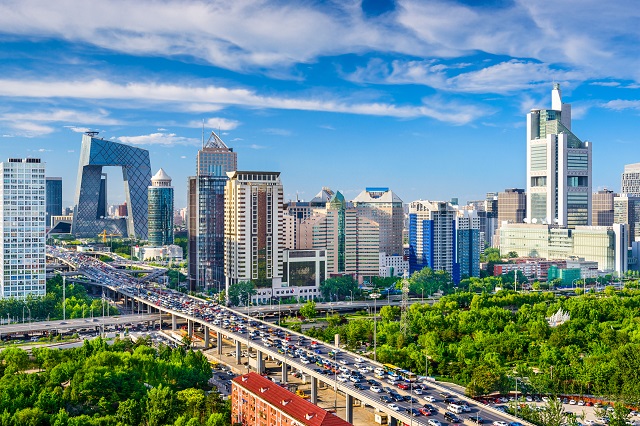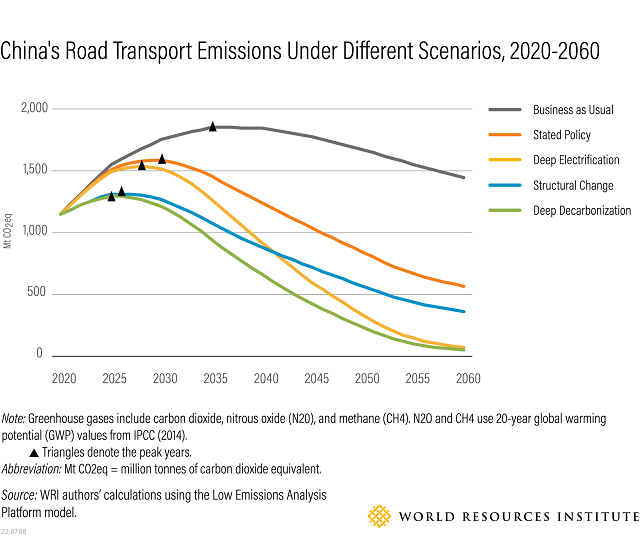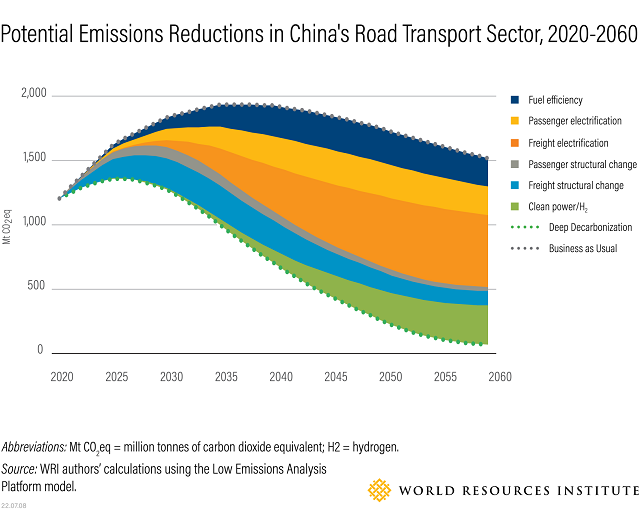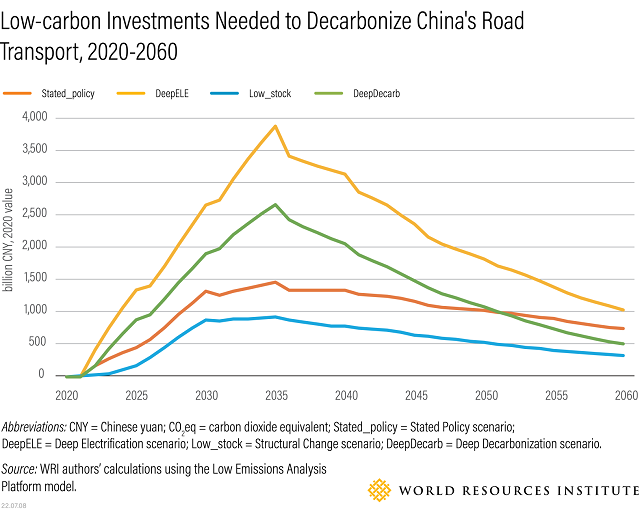
The world’s ability to overcome the climate change challenge hinges, in part, on what happens on China’s roads.
China’s cars, buses, trucks, shipping and other transport generated 828 million tonnes of greenhouse gases in 2014. That’s almost the equivalent of the EU and UK’s transport emissions combined. The country accounted for 11% of the worlds transportation emissions in 2018 — second only to the United States, which produced 21% of the total.
And unlike the generally declining trends seen in emissions from power and industry, transport emissions are rising in China and other countries. If current trends continue, China will have the most road freight activity in the world by 2050. China and India combined will experience the most rapid growth in car ownership — 6 times greater than in 2015.
But there is also major opportunity for decarbonization: Unlike aviation and maritime shipping, where immature technologies and high abatement costs limit potential emissions reductions, technology breakthroughs such as electric powertrains and hydrogen fuel cells already exist for road transport. Combined with structural changes that alter the shape of the vehicle fleet, WRI analysis finds that China can cut its road transportation emissions by up to 95% over the next 40 years while also improving air quality.
Decarbonizing China’s Road Transport
China’s national climate plan calls for carbon dioxide emissions to peak in 2030 and for the country to become carbon-neutral by 2060. WRI evaluated possible pathways to decarbonize China’s road transport sector, as well as the cost-effectiveness of different decarbonization policies and their effects on air pollution.
We found that if China implements its stated national policies — such as the Action Plan for Carbon Dioxide Peaking Before 2030, NEV Industrial Development Plan 2021-2035 and the Technology Roadmap for Energy-Saving and New Energy Vehicles 2.0 — the country’s road transport emissions could peak before 2030 and petroleum consumption before 2027. If the country goes even further through structural change policies — including increasing vehicle occupancy and shifting from private cars and trucks to low-emitting modes like buses and freight railways — it would advance the peaking timeline to 2025 for GHG emissions and 2024 for petroleum consumption.
Over the long-term, we found China can reduce road transport emissions in 2060 by 50-95% compared to 2020 under several scenarios. Specifically, if China implements the policies highlighted above, its road transport emissions could decline 50% in 2060 from 2020 levels. If the country pushes through radical shifts in vehicle technologies and travel patterns, emissions could drop by as much 93-95% in 2060 compared to 2020 levels, nearly realizing China’s 2060 carbon-neutrality commitment.
These emissions reductions would come with significant co-benefits, such as reduced air pollution. Chinese cities have some of the worst air pollution in the world, and in Shenzhen and Beijing, transportation has become the largest source of air pollutant (PM2.5). Improving the air quality can reduce premature deaths as well as the incidence of heart, respiratory and nervous diseases.

3 Ways to Achieve Deep Decarbonization in China’s Road Transport Sector
To achieve the largest emissions-reduction potential of 95% by 2060 — what we call the deep decarbonization scenario — three measures are critical:
- Vehicle electrification and clean power — including battery electric vehicles and hydrogen fuel cell electric vehicles — have the largest decarbonization potential, contributing 48% of the cumulative GHG emissions reductions compared to the baseline business as usual scenario. If the power and hydrogen-related sectors get significantly greener, following existing roadmaps outlined by the national government and industrial associations, emissions reductions from vehicle electrification could increase even more, to 60%.
- Structural changes — including shifting from private cars to buses and improving vehicle occupancy — have the second-largest mitigation potential and can cut cumulative road transport emissions by 23% by 2060. In the near-term, from 2020 to 2035, structural changes have the largest mitigation potential because vehicle electrification is not likely to reach major tipping points during this timeframe, particularly among heavy-duty trucks.
- Vehicle fuel-efficiency improvements can generate an additional 17% of cumulative emissions reductions from 2020 to 2060.
Ultimately, for China to achieve its carbon-neutrality goal, it must make its policies more ambitious. For vehicle electrification, zero-emission vehicles need to represent 100% of passenger car sales by 2035 and 100% of heavy-duty truck sales by 2050. Structurally, China needs to achieve a 75-85% green transport mode share for passenger transport (including bikes, walking and public transport) and 60% low-emitting mode share for freight transport (including railway and water navigation) by 2060.

Unlocking the Potential of Freight
Decarbonizing road freight could yield more than double the emissions reductions of passenger transport from 2020 to 2060. But this requires special attention to policies and technologies.
Policymakers need to tackle the hard-to-abate truck sector, including long-haul, heavy-duty and refrigerated trucks. Current zero-emission vehicle technologies are not only more expensive than diesel vehicles, but also lack the charging infrastructure, battery ranges and vehicle durability to support long-haul operations. In addition to advancing and promoting these technologies, long-haul freight could be shifted to railways and waterways.
Whether liquefied natural gas (LNG) trucks should be treated as a viable decarbonization solution is also worthy of further scrutiny. LNG trucks are increasingly being adopted in China, with the government requiring zero-emission vehicles and natural gas vehicles to collectively represent 40% of annual vehicle sales by 2030. However, our analysis shows that although the CO2 emissions from an LNG heavy-duty truck are 20% lower than those from a diesel truck, the total GHG emissions-reduction potential of an LNG truck is less significant due to methane leakage.
Significant Low-Carbon Investments Are Required to Reduce China’s Road Transport Emissions
Our analysis shows that decarbonizing China’s road transport sector would require CNY 39-83 trillion ($5.9- 12.6 trillion) in investments, cumulatively, from 2020 to 2060. The investment demand is the largest from now until 2035, but will steadily decline over time. Across all decarbonization scenarios, transport will require either the largest- or second-largest investment, following the power sector.
Structural changes are the least expensive of these costs. Smaller vehicle fleet sizes, for example, reduce needed investments in power as well as in vehicle and charging infrastructure. As a result, in the two scenarios that would achieve the greatest possible emissions reduction of 93-95% compared to 2020 levels, the average abatement cost of the deep decarbonization scenario is around half the cost of the deep electrification scenario, due to an associated smaller vehicle fleet.

China’s Low-carbon Transport Strategy Has Global Implications
As both an example and because of its scale, China’s transport decarbonization strategy has important repercussions domestically and globally. WRI’s analysis indicates that getting close to carbon neutrality in road transport is possible, along with substantial air quality co-benefits but only with significant changes to current policies.
To limit global temperature rise to 1.5 degrees C (2.7 degrees F) and avert the worst impacts of climate change, research shows that global transport emissions must peak between 2020 and 2025. China’s road transport sector needs explicit sectoral emissions-reduction targets, actionable strategies and cost-effective policies to get on track.
This article originally appeared on WRI’s Insights.
Lulu Xue is Urban Mobility Manager at WRI China Ross Center for Sustainable Cities.
Daizong Liu is Director of WRI China Ross Center for Sustainable Cities.





